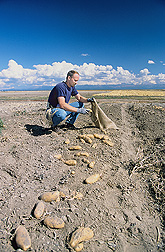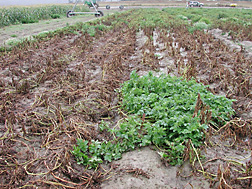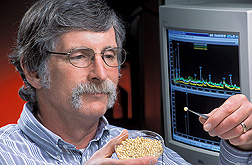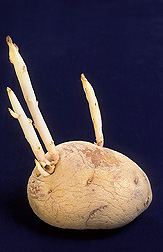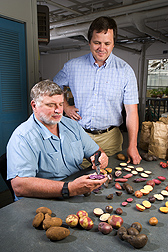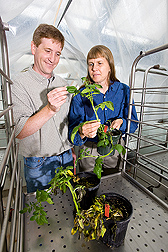Nutrient-Packed and Pest-Resistant
Potatoes From ARS Research
|
|
Potatoes are America’s number one vegetable crop. Per capita, Americans consume about 130 pounds annually. Worldwide, it’s the fourth largest crop after wheat, rice, and corn. But it’s a wonder that the potato makes it to the dinner table at all, given the myriad pests and diseases that can take hold well before harvest.
There’s the Columbia root-knot nematode, which costs U.S. growers $20 million annually; the potato tuber moth; and late blight, which caused the Irish Potato Famine of 1845 and is still responsible for significant losses and control expenses today. Chemical fumigants and fungicides have long been a staple defense for these pests and pathogens. But the onset of resistance in new pest or pathogen biotypes—coupled with environmental concerns about long-term pesticide use—has prompted the search for sustainable solutions in the form of genetic resistance.
A Recent Defender
Nationwide, ARS researchers are seeking to develop new potato varieties that will not only hold their own against insects and disease, but also maintain their storage quality and deliver nutrients that promote health and well-being in spud lovers the world over.
|
|
For example, at ARS’s Small Grains and Potato Germplasm Research Unit in Aberdeen, Idaho, geneticist Rich Novy and plant pathologist Jonathan Whitworth spearhead a program to develop new potato lines that are resistant to different biotypes of the late blight pathogen, Phytophthora infestans. Toward that end, they’re collaborating with Héctor Lozoya-Saldaña, a potato researcher in Chapingo, Mexico, where late blight is endemic.
“We send 2,500 breeding clones annually to Chapingo, where Lozoya-Saldaña evaluates them for late blight resistance,” says Novy. “We then have a duplicate planting of those same breeding clones at Aberdeen, where—based on his late-blight readings—we concurrently select resistant clones and advance them in our program,” based on their agronomic performance under irrigated production in the western United States.
The late blight-resistant cultivar Defender is an example of a recent release (2006) from the program. Defender has helped growers save on fungicides and other expenses associated with controlling late blight, which attacks the crop’s leaves and tubers, rendering the latter unmarketable. Over the next few years, Defender may be joined by one more blight-resistant potato variety, depending on how it performs in ongoing trials in Idaho, Oregon, Washington, California, and Texas.
Typically, potatoes evaluated by Novy and Whitworth—and released in collaboration with university colleagues and the grower-supported Potato Variety Management Institute—are selected for their likelihood of success in the western United States. But requests for such releases also originate from other regions of the country and from outside the United States, where some of the same problems occur.
|
|
Saving Stored Spuds
Potato diseases are costly, but so are postharvest losses, which range from 10 to 30 percent of the harvested crop. Postharvest losses result mainly from early sprouting and infections caused by wounds suffered during harvest. Some potato varieties also lose nutritional and processing quality faster than others during extended storage.
“Most potatoes come from family farms that cannot afford to take such losses,” says Jeff Suttle, research leader in the ARS Sugarbeet and Potato Research Unit at Fargo, North Dakota, and its work site at East Grand Forks.
Marty Glynn, Suttle’s colleague at East Grand Forks, works closely with the Northern Plains Potato Growers Association and public potato breeding programs across the United States to evaluate the storage properties of promising new potato varieties. The evaluations are made using a 1/20-scale processing line that exactly mimics those used by large-scale commercial processors of potato chips and French fries. This collaboration has recently given rise to two named cultivars—Dakota Crisp and Dakota Diamond, which fare well even after 9 months of storage.
|
|
Seventy percent of all U.S. potatoes are processed into chips, French fries, and dehydrated flakes. Maintaining adequate potato storage quality for processing—in some cases up to 10 months—is paramount to potato producers and processors.
Two priorities for storage managers are wound-healing and sprout control. Potatoes are wounded during harvest and must heal in order to prevent infection by other pathogens. Chemist Ed Lulai, with ARS in Fargo, has identified hormonal signals stimulating the healing process.
At harvest, potatoes are dormant. During storage, dormancy ends and sprout growth commences. Sprouting, in turn, results in numerous biochemical changes, which diminish the nutritional and processing qualities of potatoes. Postharvest sprouting is typically controlled during storage with chemical inhibitors. The long-term goal of Suttle’s program is to find less costly, nonchemical solutions to the problem by identifying the genetic cause for early-sprouting tubers. The researchers have identified internal mechanisms that signal sprouts to grow, and they are currently isolating the genes responsible for these signals. Once identified, these genes can be used in potato breeding programs to modify the sprouting characteristics of any given potato line.
|
|
Improved nutrition is another objective: For example, at Aberdeen, the focus is on elevated protein and vitamin C content. Clearwater and Classic, both varieties released in 2008, boast 30 to 40 percent more protein than the Russet Burbank variety.
At ARS’s Vegetable and Forage Crop Research Unit in Prosser, Washington, geneticists Chuck Brown and Roy Navarre are seeking increased antioxidant activity and elevated levels of phytochemicals.
Together with colleagues, they’ve devised new analytical methods for detecting and measuring phytochemical concentrations in tubers. Using these methods, they found a range of phenolic concentrations—from 100 to more than 1,500 milligrams per 100 grams dry weight—in both wild and cultivated potato lines. Phenolics may help diminish cardiovascular disease, respiratory problems, and certain cancers, the researchers say. One type, chlorogenic acid, is being tested by university cooperators for its potential to lower blood pressure. And, says Navarre, some of these potatoes have high levels of antioxidants (more than 300 micromoles Trolox equivalents per gram dry weight) that rival vegetables like spinach.
The data from Prosser shows the potential for developing high-phytonutrient potatoes. But without a reliable source of disease and/or pest resistance to protect them, such spuds would be less apt to deliver their health-promoting payloads to consumers worldwide. That’s why Brown and colleagues have developed germplasm lines like PA99N82-4, a Russet potato that resists Columbia root-knot nematodes. These wormlike parasites cause unacceptable tuber defects, and fumigants are required to produce potatoes where the nematodes exist.
|
|
Each growing region has its own unique combination of pest and pathogen problems or other peculiarities. Thankfully, ARS’s potato research locations are strategically located to address them, typically in collaboration with state universities and affected industries. The result is an interconnected network that not only benefits the U.S. potato industry, but other nations as well. That’s especially important given today’s increasing global commerce and the unique challenges and opportunities it presents.—By Jan Suszkiw and Alfredo Flores, Agricultural Research Service Information Staff.
This research is part of Plant Genetic Resources, Genomics, and Genetic Improvement (#301), Plant Biological and Molecular Processes (#302), and Plant Diseases (#303), three ARS national programs described at www.nps.ars.usda.gov.
To reach scientists featured in this article, contact Jan Suszkiw, USDA-ARS Information Staff, 5601 Sunnyside Ave., Beltsville, MD 20705-5129; (301) 504-1630.
Fighting Potato Diseases by Enhancing Germplasm
Geneticists Dennis Halterman and Shelley Jansky, with ARS’s Vegetable Crops Research Unit in Madison, Wisconsin, are hunting for wild potatoes that contain resistance to important diseases plaguing potato growers nationwide.
One wild potato Halterman has identified, Solanum verrucosum, contains a gene with resistance to late blight. Efforts are under way to cross S. verrucosum with cultivated potato and integrate the late blight resistance gene.
The researchers are looking to produce germplasm useful for developing a potato cultivar with resistance to both late blight and early blight, which also affects tomatoes. Early blight, a fungal disease, mainly affects the potato plant’s leaves and stems but, if left uncontrolled, can also reduce yield. To create the multi-disease-resistant cultivar, the scientists crossed S. verrucosum with another wild potato species that has resistance to early blight, and then crossed the resulting wild potato hybrid with cultivated potato. They currently have seedlings in the greenhouse waiting to be field tested.
Halterman and Jansky are also looking for resistance to Verticillium wilt, another fungal disease that can remain in the soil for up to 10 years. Halterman developed a molecular marker to screen germplasm for resistance to this disease, saving the scientists time and effort. They found resistance in the wild potato species S. chacoense and produced cultivated potato hybrids that contain the important gene. According to Halterman, this is a good, durable gene that should hold up in the long term.
The scientists are also targeting the potato diseases potato virus Y and common scab.—By Stephanie Yao, Agricultural Research Service Information Staff.
"Nutrient-Packed and Pest-Resistant Potatoes From ARS Research" was published in the May/June 2010 issue of Agricultural Research magazine.







